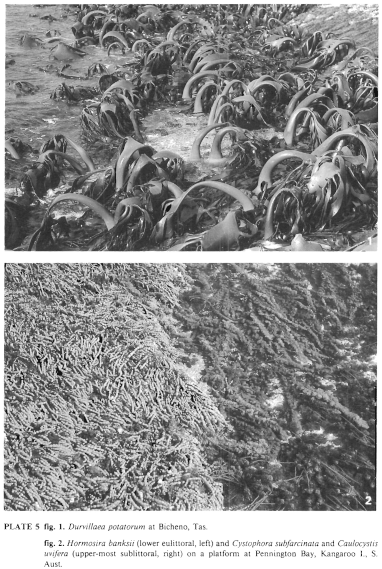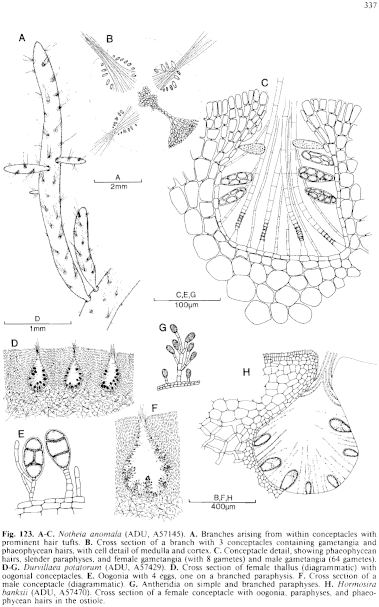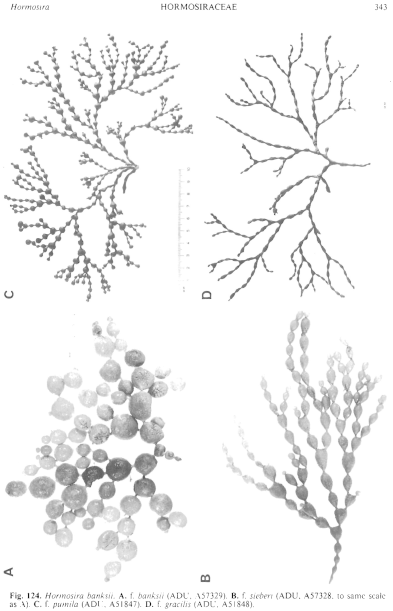|
|
|
|
|
|||||||||||
|
Electronic Flora of South Australia Species Fact Sheet
Phylum Phaeophyta – Order Fucales – Family Hormosiraceae
Selected citations: Clarke & Womersley 1981: 497, figs 1–3. Clayton et al. 1985: 181, figs 1–20. Harvey 1860: pl. 135. Lindauer et al. 1961: 320, pls 72, 81. Lucas 1936: 80. Womersley 1967: 249.
Synonym
Fucus banksii Turner 1808: 1, pl. 1.
Thallus (Pl. 6 fig. 2; Fig. 124) medium to dark brown, (5–) 10–30 cm long, with one to several fronds from a thin, discoid, holdfast 3–10 mm across, epilithic or occasionally free floating. Fronds simple to several times subdi- or polychotomously branched at close to distant intervals, formed of a series of moniliform vesicular segments, slender near the base, mostly 5–15 (–30) mm in diameter, varying from elongate-ovoid to subspherical depending on the variety, connected by narrow internodes 1–5 mm long and 1–2 mm thick, becoming slightly verrucose as conceptacles develop. Growth from a group of 4 adjacent apical cells, each three-sided in transverse section, in an apical groove. Structure of hollow segments with an inner, filamentous, reticulate, medulla, a parenchymatous cortex and outer meristoderm.
Thallus compressed to flat, subdichotomous to laterally branched, branches linear to tapering, basally constricted or not, costate or ecostate, with or without vesicles; holdfast discoid or hapteroid. Growth from a single or a small cluster of four-sided apical cells (three-sided in juvenile plants of some taxa). Structure with a medulla of elongate cells and hyphae, a cortex of isodiametric cells and a surface meristoderm.
Reproduction: Thalli dioecious. Conceptacles scattered over the segments, largely within the cortex, with sex organs, simple paraphyses, and phaeophycean hairs within the ostiole. Female conceptacles (Fig. I23H) with sessile, obovoid to clavate, oogonia, 120–160 µm long and 40–80 µm in diameter, forming 4 eggs. Male conceptacles with antheridia on branched paraphyses, elongate-ovoid, 30–40 (–45) µm long and 7–14 µm in diam.
Thalli monoecious or dioecious. Receptacles developing as slightly to distinctly swollen ends of branches, with scattered conceptacles; oogonia sessile, ovoid, with 1, 2, 4 or 8 eggs; antheridia on branched paraphyses, producing 64 sperms. Embryos with a single primary rhizoid.
Type from "Nov. Holl."; in BM (ex K).
Distribution: From King George Sound, W. Aust., around southern Australia and Tasmania to Port Macquarie, N.S.W.
Lord Howe I., Norfolk I., New Zealand.
Taxonomic notes: Some 5 forms can be distinguished on morphology and their ecological situation. Clarke & Womersley (1981) showed that four of these forms are interfertile, though zygotes were not grown beyond juveniles.
The following ecoforms can be recognised (Clarke & Womersley 1981, p. 499):
f. banksii Harvey 1860: pl. 135 fig. 1 (Fig. 124A)-vesicles subspherical, mostly 1–2 cm in diameter; occurring on sheltered platforms or on mussels etc. on sandy-muddy tidal flats, or free-floating in mangrove communities.
f sieberi (Bory) Harvey 1860: pl. 135 fig. 4 (Pls 5 fig. 2, 6 fig. 2; Fig. 124B)-vesicles oblong to obovoid, usually 7–15 mm long and 5–10 mm broad, in long chains, occasionally branched; occurring on rough-water platforms in pools and the lower eulittoral.
f. monila Sonder 1853: 667 (Fig. 124C)-vesicles obovoid to spherical, 2–7 mm long and broad, thallus frequently branched; occurring in the lower eulittoral or pools under moderate water movement.
f. gracilis (Kützing) Harvey 1860: pl. 135 figs 5,6 (Fig. 124D)-vesicles obovoid to fusiform, usually 5–6 mm long and 2–3 mm broad, air space small; occurring just below low tide level in moderate water movement.
f. billardieri (Montagne) Harvey 1860: pl. 135 fig. 2-vesicles triangular in outline, 15–25 mm long and 10–20 mm broad; occurring in the lower eulittoral under moderate water movement.
f. banksii - Proper Bay, Port Lincoln, S. Aust., lower eulittoral (Womersley, 12.v.1968; ADU, A32474). Cowell, S. Aust., free floating amongst mangroves (Womersley, 14.i.1984; ADU, A54721). Port Arthur, upper Gulf St Vincent, S. Aust., free floating amongst mangroves (14Mnersley, 9.xi.1980; ADU, A51849). Rosetta Bay, Victor Harbor, S. Aust., lower eulittoral (Womersley, 3.xii.1986 and 19.iv.1987; ADU, A57329 and ADU, A57470-"Marine Algae of southern Australia" No. 288). American R. inlet, Kangaroo I., S. Aust., lower eulittoral ( Womersley, 6.i.1948; ADU, A6738).
f. sieberi - Albany, W. Aust., drift (Levring, 6.vii.1948; ADU, A56029). Wanna, S. Aust., lower eulittoral (Womersley, 19.ii.1959; ADU, A22340). Pennington Bay, Kangaroo I., S. Aust., lower eulittoral (Womersley, 4.i.1948; ADU, A6436). Petrel Cove, Victor Harbor, S. Aust., lower eulittoral (Womersley, 3.xii.1986; ADU, A57328). Flinders, Vic., lower eulittoral pools (Christianson, 25.x.1984; ADU, A56204, with long (4–10 cm) terminal vesicles without constrictions). Boat Harbour Beach, Tas.. lower eulittoral pools (Womersley, 4.x.1986; ADU, A57268). Avoca Beach, N.S.W., lower eulittoral (14 Womersley, 18.i.1981; ADU, A51981).
f. pumila - Aldinga, S. Aust., low eulittoral pools (Womersley, 26.x.1980; ADU, A51847). Cape Portland, N.E. Tas. (Levring, 8.ii.1948; ADU, A56042).
f. gracilis — Victor Harbor, S. Aust., uppermost sublittoral ( Womersley, 26.x.1980; ADU, A51848). Rosetta Bay, Victor Harbor, S. Aust., uppermost sublittoral ( Womersley, 19.iv.1987; ADU, A57471-"Marine Algae of southern Australia" No. 289).
f. billardieri - Northern Spencer Gulf, S. Aust., lower eulittoral (Johnson, 15.viii.1978; ADU, A49771). Port Fairy, Vic., low eulittoral ( Womersley, 2.iv.1981; ADU, A52074).
The numerous names included under H. banksii are listed by Womersley (1967, p. 249). FAMILY FUCACEAE Adanson
A family of about 8 genera, mainly of Northern Hemisphere distribution, with only Xiphophora on Australian coasts.
References:
CLARKE, S.M. & WOMERSLEY, H.B.S. (1981). Cross-fertilization and hybrid development of forms of the brown alga Hormosira banksii (Turner) Decaisne. Aust. J. Bot. 29, 497–505.
CLAYTON, M.N., HALLAM, N.D., LUFF, S.E. & DIGGINS, T. (1985). Cytology of the apex, thallus development and reproductive structures of Hormosira banksii (Fucales, Phaeophyta). Phycologia 24, 181–190.
DECAISNE, J. (1842). Essais sur une classification des Algues et des Polypiers Calciferes de Lamouroux. Ann. Sci. nat. (Bot.), Ser. 2, 17, 297–380, Plates 14–17.
HARVEY, W.H. (1860). Phycologia Australica. Vol. 3, Plates 121–180. (Reeve: London.)
LINDAUER, V.W., CHAPMAN, V.J. & AIKEN, M. (1961). The marine algae of New Zealand. II. Phaeophyceae. Nova Hedwigia 3, 129–350, Plates 57–97.
LUCAS, A.H.S. (1936). The Seaweeds of South Australia. Part 1. Introduction and the Green and Brown Seaweeds. (Govt Printer: Adelaide.)
SONDER, O.W. (1853). Plantae Muellerianae. Algae. Linnaea 25, 657–709.
TURNER, D. (1808). Fuci sive Plantarum Fucorum Generi a Botanicis Ascriptarum Icones Descriptiones et Historia. Vol. 1, pp. 1–164, Plates 1–71. (London.)
WOMERSLEY, H.B.S. (1967). A critical survey of the marine algae of southern Australia. II. Phaeophyta. Aust. J. Bot. 15, 189–270.
The Marine Benthic Flora of Southern Australia Part II complete list of references.
Publication:
Womersley, H.B.S. (14 December, 1987)
The Marine Benthic Flora of Southern Australia
Part II
©Board of the Botanic Gardens and State Herbarium, Government of South Australia
Illustrations in Womersley Part II, 1997: PLATES 5 fig. 2, 6 fig. 2; FIGS 123H, 124.

Plate 5 enlarge
PLATE 5 fig. 1. Durvillaea potatorum at Bicheno, Tas.
fig. 2. Hormosira banksii (lower eulittoral, left) and Cystophora subfarcinata and Caulocystis uvifera (upper-most sublittoral, right) on a platform at Pennington Bay, Kangaroo I., S. Aust.

Figure 123 enlarge
Fig. 123. A–C. Notheia anomala (ADU, A57145). A. Branches arising from within conceptacles with prominent hair tufts. B. Cross section of a branch with 3 conceptacles containing gametangia and phaeophycean hairs, with cell detail of medulla and cortex. C. Conceptacle detail, showing phaeophycean hairs, slender paraphyses, and female gametangia (with 8 gametes) and male gametangia (64 gametes). D–G. Durvillaea polatorum (ADU, A57429). D. Cross section of female thallus (diagrammatic) with oogonial conceptacles. E. Oogonia with 4 eggs, one on a branched paraphysis. F. Cross section of a male conceptacle (diagrammatic). G. Antheridia on simple and branched paraphyses. H. Hormosira banksii (ADU, A57470). Cross section of a female conceptacle with oogonia, paraphyses, and phaeophycean hairs in the ostiole.

Figure 124 enlarge
Fig. 124. Hormosira banksii. A. f. banksii (ADU, A57329). B. f. sieberi (ADU, A57328, to same scale as A). C. f. pumila (ADU, A51847). D. f. gracilis (ADU, A51848).

|
Email Contact: State Herbarium of South Australia |

|